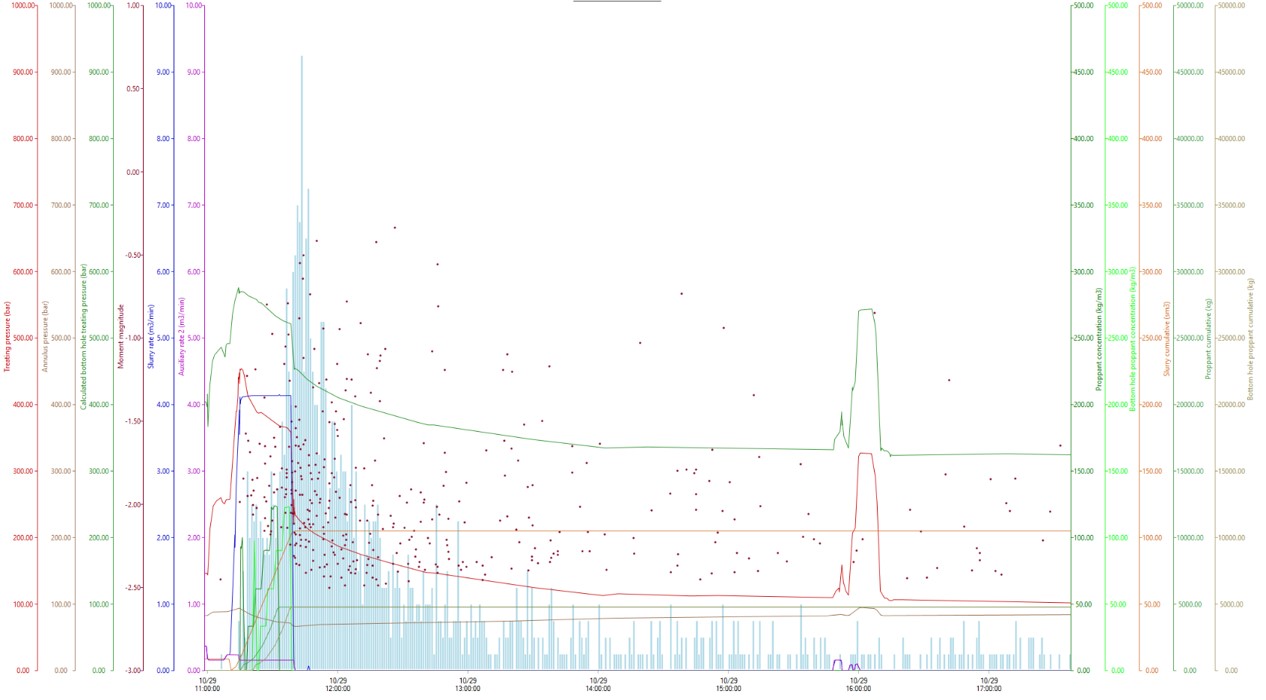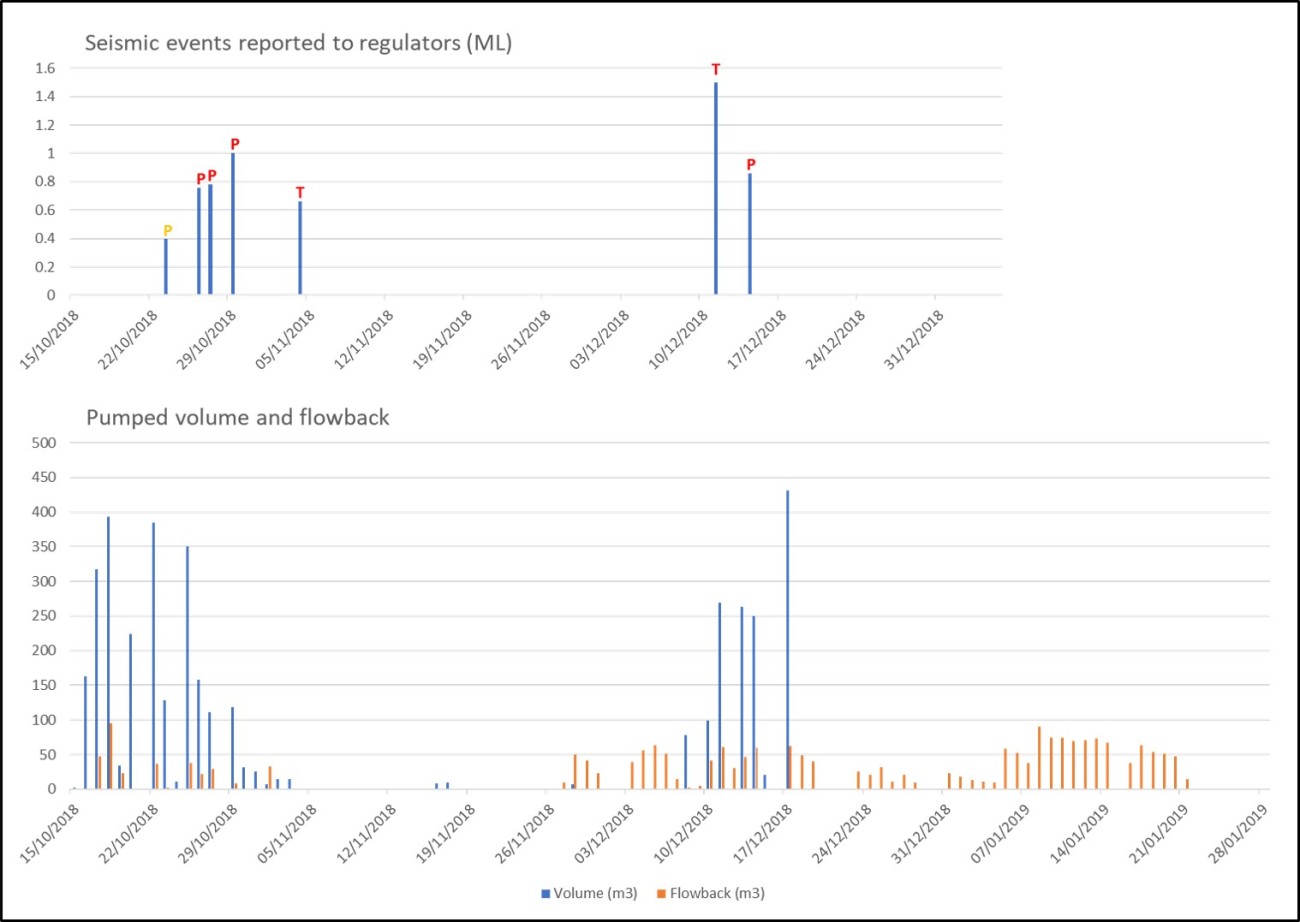
Fracking image of pumping at Preston New Road on 29 October 2019. Source: Cuadrilla Resources
Data from fracking at Cuadrilla’s fracking site in Lancashire last year has been published by the industry regulator, the Oil & Gas Authority.
Cuadrilla had previously disclosed that it fully fracked only two of the proposed 41 stages during the operation – the first to work under the traffic light system for fracking-induced earth tremors.
The new material confirmed that fracking at the Preston New Road site stopped prematurely four times because of seismicity which exceeded the limit in the regulations of 0.5 local magnitude (ML).
Regulators were informed about these and another five seismic events.
The disclosures include previously unreleased “key learnings” on the fracking operation, carried out between October and December 2018.
The hydraulic fracturing report said:
“the microseismic data collected demonstrates a relationship between injection activities and induced micro-seismicity”.

Comparison of pumped volume and seismic events reported by Cuadrilla to regulators. Red Ps represent red events under the traffic light system. The amber P is an amber event. The red T is a trailing event which happened after pumping. There were also two more smaller amber events on 11/12/2018. Source of information: Cuadrilla Resources
The report said there were a total of 38,383 microseismic events.
Of the nine events reported to regulators under the traffic light system, six happened during fracking:
- 3 amber events during pumping where seismicity exceeded 0.0ML
- 3 red events during pumping where seismicity was 0.5ML or above
- 3 trailing events after pumping where seismicity was 0.5 or above
The report said only 17 of the planned 41 injection sleeves were hydraulically stimulated with either a mini and/or a main fracking. The volume of fluid used at each fracking stage was well below the 765m3 maximum proposed by the company.
Interpretation of microseismic data had identified two additional faults, the company also reported.
Reservoir and gas composition
The report said data from drilling and fracking revealed that the Bowland shale had “good reservoir and completion properties”.
It said 96% of the gas analysed from the well was methane. 1.6% was ethane, 0.2% propane and 0.02% isobutane. Hydrogen sulphide was 0%, according to the report.
Other information disclosed includes daily records, pumping data, records of seismic events, hydraulic fracturing images and details on sleeve depths.
Some of this information was already in the public domain following freedom of information requests. (See earlier DrillOrDrop article)
Regulator’s analysis
The Oil & Gas Authority said its analysis of Cuadrilla’s data was now underway. This was not, the OGA said, a review of the traffic light system, which has been requested by the shale gas industry.
The OGA said it had appointed lead scientists for four different areas of analysis:
- British Geological Survey – forecasting distribution and magnitude of seismicity
- Dr Ben Edwards – impacts of ground motion from seismicity
- Nanometrics Inc – real time forecasting to mitigate effects of seismicity
- Outer Limits Geophysics – induced seismicity and potential subsurface mechanisms
Next stage
Cuadrilla has submitted a hydraulic fracturing plan for its second well at Preston New Road, PNR-2. This has to be approved by the Environment Agency and Oil & Gas Authority.
The company said it would be publishing an operational update in the next month.
Categories: Industry

Thanks Eli-Goth. Sir James heads up the Environment Agency, as such I would expect him to refer to teams of superqualified scientists to create his viewpoints.
If not the case the Gold Standard Monitors are not doing their job. Although his statements rather say that they are as regards Climate Change/Destruction.
Super-qualified? What are his thoughts on Climate Destruction. Thats a new one on me, is this suppose to make us more guilty? I suppose his little speech would be better served for country’s and regions like West Africa, China and Indian where they have no intentions on taking the defensive climate change agenda. Not little old UK where out needle in a hay stack although in our minds sufficient, too little to make a difference!
Peter – Environment Agency Policy:
“We are often asked whether we support development of the industry. As the independent regulator, our role is not to be for or against fracking but to ensure the right regulatory controls are in place.”
More information here:
https://environmentagency.blog.gov.uk/2018/10/17/fracking-protecting-the-environment/
Sir James is head of a regulator whose job is to regulate……
‘Regulate’ being the obvious word!
It is ‘official’. Global tree planting and reforestation os the cheapest and most actionable approach to reduce CO2.
At roughly US 50c per tree and to plant 1 trillion trees it could reduced 70% of all global human CO2 emission. It costs only half a $ trillion to achieve and have a minimal negative impact on the economy and industry.
Compared to the madness fallible UK net zero target costing £1 trillion to reduce 1.5% of human CO2 emission.
https://www.theguardian.com/environment/2019/jul/04/planting-billions-trees-best-tackle-climate-crisis-scientists-canopy-emissions
TW: that is a good point but you cannot plant trees anywhere, you cannot plant them on expensive and productive agricultural land, bog land and windy environment land like the scottish highlands, these would not be suitable as you also need to sequester huge areas of land you cannot use for anything else. Hence once you’ve planted your trees then you cannot do anything with that land, it will be reducing carbon dioxide but the land would also be worthless, a land owner just wouldn’t want to own worthless land!
I recall Eli-Goth that there used to be schemes for farmers in UK that provided a regular income from tree planting, to encourage them to grow trees on unproductive corners of land, and reflect that the harvest would be decades away. Could be updated, but of course, the tax payer would have to fund. (Not such a crazy idea as UK will recover control of the agricultural money sent off to EU which was not then returned in the best way to UK farmers.)
Personally, I would like to see some more Elms replaced now there seems resistant strains identified. They were pretty impressive trees and were host to a whole, specific, eco system.
However, lots of tall trees and on shore wind turbines do not mix well! So, whilst John has an interest in seeing more of them it seems logical to plant trees on land and place turbines in the sea and integrate that with fishery nurseries as UK will also recover control of fishing matters. That could also link quite nicely to increasing fish consumption at the expensive of red meat, that could lose some grazing land.
But, of course, that sort of initiative requires some politicians to produce integrated plans. Don’t hold your breath!
Planting trees will be a big help as this can be undertaken globally and could therefore have a very positive impact on climate change. Giving up chocolate and anything to do with palm oil in the west will help significantly. Also from the Guardian recently:
https://www.theguardian.com/environment/2019/apr/25/death-by-a-thousand-cuts-vast-expanse-rainforest-lost-in-2018
“Millions of hectares of pristine tropical rainforest were destroyed in 2018, according to satellite analysis, with beef, chocolate and palm oil among the main causes.
The forests store huge amounts of carbon and are teeming with wildlife, making their protection critical to stopping runaway climate change and halting a sixth mass extinction. But deforestation is still on an upward trend, the researchers said. Although 2018 losses were lower than in 2016 and 2017, when dry conditions led to large fires, last year was the next worst since 2002, when such records began.
Clearcutting of primary forest by loggers and cattle ranchers in Brazil dominated the destruction, including invasions into indigenous lands where uncontacted tribes live. Losses were also high in the Democratic Republic of the Congo (DRC) and Indonesia. Indonesia is the only major country where government protections appear to be significantly reducing the losses.
Ghana and Ivory Coast recorded the biggest percentage rises in rainforest destruction, driven by gold mining and cocoa farming.”
https://www.theguardian.com/world/2019/jul/03/brazil-amazon-rainforest-deforestation-environment
“Deforestation in Brazil’s portion of the Amazon rainforest rose more than 88% in June compared with the same month a year ago, the second consecutive month of rising forest destruction under the rightwing president Jair Bolsonaro.
According to data from Brazil’s space agency, deforestation in the world’s largest tropical rainforest totaled 920 sq km (355 sq miles).
The data showing the 88.4% deforestation increase is preliminary, but indicates the official annual figure, based on more detailed imaging and measured for the 12 months to the end of July, is well on track to surpass last year’s figure.
In the first 11 months, deforestation has already reached 4,565 sq km (1,762 sq miles), a 15% increase over the same period in the previous year.”
Planting trees is just a sticking plaster Paul. It will not be successful unless we radically reduce emissions at the same time. The young trees absorb the carbon but as they mature the net effect is zero and then on decomposition or burning will release the carbon back into the cycle.
It can only be a temporary fix to hold back the escalation, but as there is at least 100 years worth of excessive carbon stored in the oceans, it may already be too late to minimize the effect on our climate. The love of money may have destroyed us all….
As the article and publication pointed out. Tree planting in temperate and tropical regions are the most effective. And the numbers are not calculated and included yhe agriculture land. More trees lining the street would help. In case of house holds more tree in the ground or big pot. And the UK can certainly offset its CO2 by sponsoring reforestation tree planting oversea. And work with those countries to prevent further deforestation.
Together with CO2 capture technology powered by renewables.
The other point is tree planting is the cheapest and most actionable approach. It can be done by the public and can be implemented quickly without significant disruption to the economy and industry. And let new green technologies more times to take shape.
And dont forget sea grasses and seaweed. They absorb 15x more CO2 than rainforests.
Sea grass is an interesting one, TW.
There was a reserve in the Helford Estuary last time I was there that was protected and a breeding area for sea bass. There was a fishing restriction upon that area to allow the breeding to take place, and then the sea bass could grow and repopulate along the coast-that used to be renowned for some of the best sea bass fishing.
Unfortunately, slap bang in the middle of that is the granite quarry some want to blast to kingdom come to enable the Swansea Lagoon!
I know which project I would prefer to support-and, most of the Cornish population in that area feel the same.
Sometimes it makes you feel the green clean technology is not at all about CO2 reduction or the environment it tries to save but it is all about feeling good about it.
And making money, lots of it. Which I don’t have a problem with but I get fed up with people pretending this green revolution is only for the greater good……
I agree with you on this one.
Sadly, the love of money drives our economy and clouds our judgement…
That said, I would rather have investment in green technology than dirty fossil fuel….
There is an interesting philosophical argument that clean and green energy which can be generated by individuals, will disconnect the masters from the slaves and restore the status quo……this will be interesting to watch.